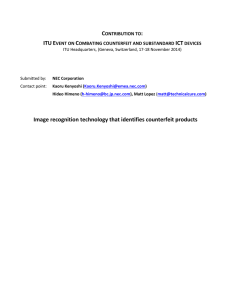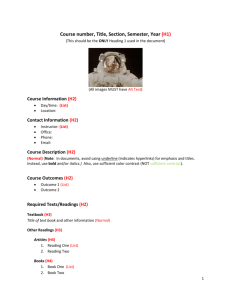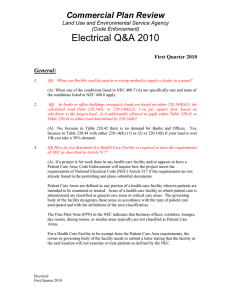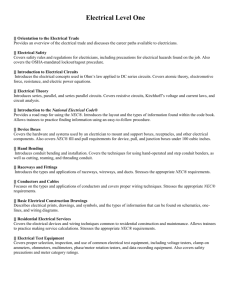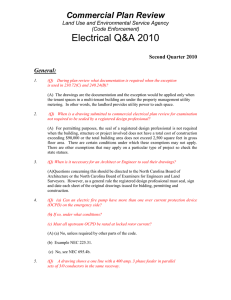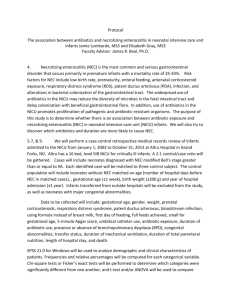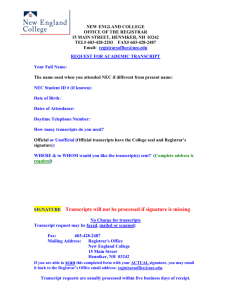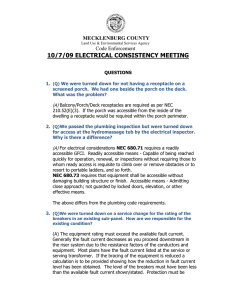AGEC 640 * Explaining Policies: The Political Economy of
advertisement
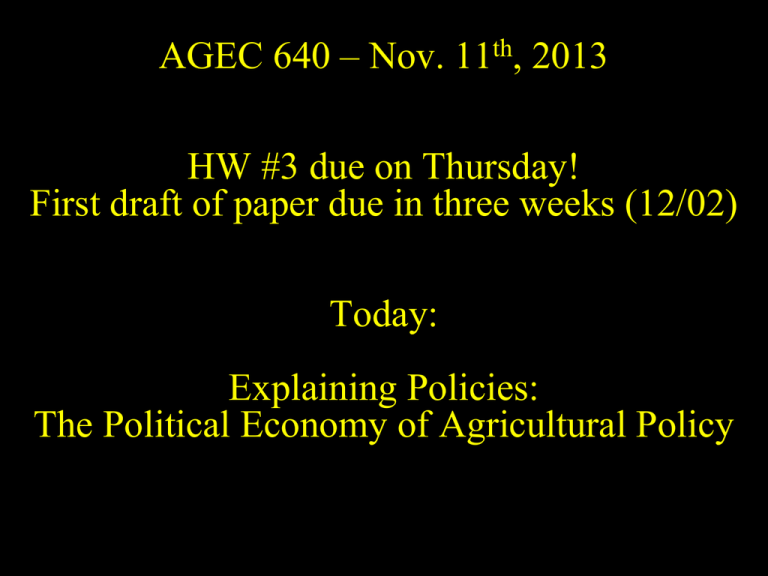
AGEC 640 – Nov. 11th, 2013 HW #3 due on Thursday! First draft of paper due in three weeks (12/02) Today: Explaining Policies: The Political Economy of Agricultural Policy So how can people get government to help them towards Q*? – societies differ in their choice of mechanism, and also in how close they get to Q* – we could explain this in terms of “amateur sociology” (or real history, politics, anthropology, psychology, etc.) – but we can also explain policies in terms of real economics (=“political economy”): • assume policy-makers are optimizers, ask what function they optimize; • explain policy choices as equilibrium among optimizers, ask what kind of political market structure gives observed outcomes? The many literatures of political economy • Classical political economy (1750s-1890s) – Hobbes, Locke, Smith, Marx; now “political philosophy”… • Marxian political economy (1920s-1970s) – Modeling social groups as autonomous agents (“classes”) • Today’s political economy (1960s-present) – “positive political economy” • “positive” studies of what is, as opposed to “normative” studies of what should be. – “neoclassical political economy” • “neoclassical” economics using mathematical methods, as opposed to “classical” work using only natural language – “public choice” or “rational choice” • terminology from the 1970s and 1980s In the simplest political economy models, we are already in the best of all possible worlds! • If everyone is optimizing, observed policies might maximize aggregate welfare. What kinds of political markets would “rationalize” observed policies in this way? – Some benevolent-dictator models (in which omnipotent leaders maximize their dynastic wealth) – Some median-voter models (in which leaders seek policies that appeal to 50%+1 voters) – Some Tiebout-sorting models (from Tiebout 1956) (in which leaders provide a set of options, and people move to jurisdictions where policies match their preferences) • These approaches don’t work very well: real governments don’t do anything close their predictions. Trade-Weighted Tariff Equivalent (% rTMS), 2001 . 80 70 40 0 Source: GTAP database, version 6.2 (June 2006). Regions are World Bank classifications. Note: For paddy and processed rice, rTMS levels are 147% and 130% respectively Paddy rice Processed rice Cereal grains nec Sugar Wheat Oil seeds Meat: cattle,sheep etc. Meat products nec Sugar cane, sugar beet Dairy products Vegetables, fruit, nuts Wearing apparel Leather products Food products nec Bev. & tobacco Textiles Veg. oils & fats Crops nec Manufactures nec Cattle,sheep, etc. Fishing Mineral products nec Animal products nec Motor veh. and parts Ferrous metals Petrol. & coal prod. Metal products Chem.& plastic prod. Mach. & equip. nec Metals nec Transport equip. nec Wood products Oil Wool, silk cocoons Electronic equip. Paper prod.&publ. Forestry Minerals nec Plant-based fib. Coal Gas Electricity What do government’s actually do? Remember this? Dispersion of Tariff-Equivalent Protection by Income Level, 2001 Average nominal rates of protection, by income group (2001) 147 130 60 LowIncome 50 LowerMiddle UpperMiddle HighIncome 30 20 10 Who benefits from these interventions? Farm policy is not a pretty sight! Note this cartoon is from the U.S. in 2002; similar farm policies are supported by all political parties. Modern political economy: Explanations with (political) market failure • More successful models use a principal-agent approach, in which principals (people) use agents (“leaders”) to acquire public goods. • With full information, costless transactions, etc., the losers from inefficient policy could always buy out the winners, leading to Q*. • So modern models rely on transaction costs or other limits on Coasian deal-making, most notably: (1) Size of gains & rational ignorance (from Anthony Downs in a 1954 book) (2) Size of group & free-ridership (mainly from Mancur Olson in a 1965 book) (3) Accountability & rent-seeking (mainly from Anne Krueger in a 1974 article) (4) Commitment & time-consistency (due to Kydland and Prescott in 1977) (5) Loss aversion & behavioral economics (e.g. Kahnemann-Tversky 1979) (6) Probability-weighted voting (Fernandez and Rodrik 1991) Political economy theories: (1) Size of gains and the rational ignorance of losers • The basic idea of “rational ignorance” is that – learning about and participating in political action is costly, – so people won’t, unless it’s worthwhile to do so • Some implications of this model are that: – only those with relatively large stakes will participate in politics; – if people have similar and large stakes, they can lobby together; – the costs of participation can have a decisive influence; • if political information is easier to get, and • if political participation is easier to do, • then outcomes will be more economically efficient – …but participants in politics may deliberately choose confusing and ambiguous policies, to raise the costs of participation! Political economy theories: (2) Size of interest groups and free ridership • The basic idea of the “interest-group” approach is that – policy choices are inherently collective actions, – so obtaining desired policies requires limiting free-ridership • Some implications of the interest-group approach are that people will invest more in politics if they: – are few in number (so each is less likely to free-ride) – are fixed in number (so new entrants won’t free-ride) Political economy theories: (3) Rent-seeking and accountability • Some basic ideas of the “rent seeking” approach are that: – people with access to power use it to earn “policy rents” – people will use up policy rents in competitive lobbying • Some implications of the rent-seeking approach are that: – welfare costs of intervention are “Tullock trapezoids”, not “Harberger triangles”, as policy rents are “dissipated” Pd A B Pw C D For example, if producers and quota holders have to lobby hard for their gains, they could spend up to A+C so total social losses=ABCD, not just DWL triangles B+D. Political economy theories: (4) Commitment mechanisms and time-consistency • The basic idea of time-consistency is that some peoples’ irreversible commitments are influenced by others’ recurrent choices – this can cause market failure when a seemingly profitable investment is not made because, if it were, others would change behavior making it unprofitable; – For example, Masters and McMillan (2003) try to explain why some governments choose paradoxically self-defeating policies for certain crops, with both high tax rates and low R&D investment. In this model: • farmers will not invest in production without a guarantee of low taxes, but • governments cannot commit to keep taxes low, so cannot induce farmers to invest • government R&D is not profitable, but high taxes yield some revenue • tropical crops are more affected by this than temperate-zone crops • This kind of trap is very common! Political economy theories: (5) Loss aversion • Perhaps policies arise simply to limit adjustment, with the status-quo as their reference point. • This is known as – Kahnemann-Tversky “loss aversion” in behavioral economics, and as – Max Corden’s “conservative social welfare function” in trade policy analysis Either way, the implication is that people will pay more to avoid loses than to obtain gains… Political economy theories: (6) Probability-weighted voting • Fernandez and Rodrik “status quo bias” (AER 1991) • In some cases, gains/losses accrue to known people, while others are randomly distributed. Even with full rationality, this matters for politics! In their simplest example, the “gaining” sector employs 40% of the workforce; after reforms it would employ 60%. (Half of the workers in the “losing” sector would switch, but don’t know which.) • These reforms are efficient and popular after they are implemented, but unpopular beforehand and hence not implemented. • Reforms with the opposite characteristics would be reversed after adoption, hence an asymmetry and a source of “status-quo bias” =(-0.2)*(0.4)*(0.5)/(0.6) More generally, we might expect a bias towards the visible; economic growth requires “visionary” leadership in the sense of adding up costs and benefits independently of who pays/gets them Finally, choice of instruments and second-best policy • Policy-makers’ choice of policies can be influenced by the policy instruments they have available, and with more instruments can get closer to Q* • For example, – poorer countries may use trade taxes to finance desirable public goods, simply because they lack the enforcement capacity to collect income or property taxes; – so their bias against agriculture could be unintended, just because they are net agriculture exporters; but self-perpetuating as policy weakens ag. and strengthens nonag. lobbying groups. • More generally, – societies with less institutional capability will be further from Q*!
